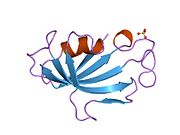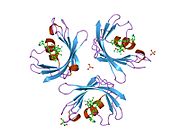FKBP1A
Peptidyl-prolyl cis-trans isomerase FKBP1A is an enzyme that in humans is encoded by the FKBP1A gene.[5] It is also commonly referred to as FKBP-12 or FKBP12 and is a member of a family of FK506-binding proteins (FKBPs).
Function
[edit]The protein encoded by this gene is a member of the immunophilin protein family, which play a role in immunoregulation and basic cellular processes involving protein folding and trafficking. This encoded protein is a cis-trans prolyl isomerase that binds the immunosuppressants FK506 (tacrolimus) and rapamycin (sirolimus). It interacts with several intracellular signal transduction proteins including type I TGF-beta receptor. It also interacts with multiple intracellular calcium release channels including the tetrameric skeletal muscle ryanodine receptor. In mouse, deletion of this homologous gene causes congenital heart disorder known as noncompaction of left ventricular myocardium. Multiple alternatively spliced variants, encoding the same protein, have been identified. The human genome contains five pseudogenes related to this gene, at least one of which is transcribed.[6]
Interactions
[edit]FKBP1A has been shown to interact with:
References
[edit]- ^ a b c GRCh38: Ensembl release 89: ENSG00000088832 – Ensembl, May 2017
- ^ a b c GRCm38: Ensembl release 89: ENSMUSG00000032966 – Ensembl, May 2017
- ^ "Human PubMed Reference:". National Center for Biotechnology Information, U.S. National Library of Medicine.
- ^ "Mouse PubMed Reference:". National Center for Biotechnology Information, U.S. National Library of Medicine.
- ^ DiLella AG (Sep 1991). "Chromosomal assignment of the human immunophilin FKBP-12 gene". Biochemical and Biophysical Research Communications. 179 (3): 1427–33. doi:10.1016/0006-291X(91)91732-R. PMID 1930186.
- ^ "Entrez Gene: FKBP1A FK506 binding protein 1A, 12kDa".
- ^ Chambraud B, Radanyi C, Camonis JH, Shazand K, Rajkowski K, Baulieu EE (Dec 1996). "FAP48, a new protein that forms specific complexes with both immunophilins FKBP59 and FKBP12. Prevention by the immunosuppressant drugs FK506 and rapamycin". The Journal of Biological Chemistry. 271 (51): 32923–9. doi:10.1074/jbc.271.51.32923. PMID 8955134.
- ^ Neye H (Mar 2001). "Mutation of FKBP associated protein 48 (FAP48) at proline 219 disrupts the interaction with FKBP12 and FKBP52". Regulatory Peptides. 97 (2–3): 147–52. doi:10.1016/s0167-0115(00)00206-8. PMID 11164950. S2CID 20617551.
- ^ MacMillan D, Currie S, Bradley KN, Muir TC, McCarron JG (Dec 2005). "In smooth muscle, FK506-binding protein modulates IP3 receptor-evoked Ca2+ release by mTOR and calcineurin". Journal of Cell Science. 118 (Pt 23): 5443–51. doi:10.1242/jcs.02657. PMID 16278292.
- ^ Cameron AM, Nucifora FC, Fung ET, Livingston DJ, Aldape RA, Ross CA, Snyder SH (Oct 1997). "FKBP12 binds the inositol 1,4,5-trisphosphate receptor at leucine-proline (1400-1401) and anchors calcineurin to this FK506-like domain". The Journal of Biological Chemistry. 272 (44): 27582–8. doi:10.1074/jbc.272.44.27582. PMID 9346894.
- ^ a b Jacinto E, Loewith R, Schmidt A, Lin S, Rüegg MA, Hall A, Hall MN (Nov 2004). "Mammalian TOR complex 2 controls the actin cytoskeleton and is rapamycin insensitive". Nature Cell Biology. 6 (11): 1122–8. doi:10.1038/ncb1183. PMID 15467718. S2CID 13831153.
- ^ a b Sarbassov DD, Ali SM, Kim DH, Guertin DA, Latek RR, Erdjument-Bromage H, Tempst P, Sabatini DM (Jul 2004). "Rictor, a novel binding partner of mTOR, defines a rapamycin-insensitive and raptor-independent pathway that regulates the cytoskeleton". Current Biology. 14 (14): 1296–302. Bibcode:2004CBio...14.1296D. doi:10.1016/j.cub.2004.06.054. PMID 15268862. S2CID 4658268.
- ^ Choi J, Chen J, Schreiber SL, Clardy J (Jul 1996). "Structure of the FKBP12-rapamycin complex interacting with the binding domain of human FRAP". Science. 273 (5272): 239–42. Bibcode:1996Sci...273..239C. doi:10.1126/science.273.5272.239. PMID 8662507. S2CID 27706675.
- ^ Luker KE, Smith MC, Luker GD, Gammon ST, Piwnica-Worms H, Piwnica-Worms D (Aug 2004). "Kinetics of regulated protein-protein interactions revealed with firefly luciferase complementation imaging in cells and living animals". Proceedings of the National Academy of Sciences of the United States of America. 101 (33): 12288–93. Bibcode:2004PNAS..10112288L. doi:10.1073/pnas.0404041101. PMC 514471. PMID 15284440.
- ^ Banaszynski LA, Liu CW, Wandless TJ (Apr 2005). "Characterization of the FKBP.rapamycin.FRB ternary complex". Journal of the American Chemical Society. 127 (13): 4715–21. doi:10.1021/ja043277y. PMID 15796538.
- ^ Sabers CJ, Martin MM, Brunn GJ, Williams JM, Dumont FJ, Wiederrecht G, Abraham RT (Jan 1995). "Isolation of a protein target of the FKBP12-rapamycin complex in mammalian cells". The Journal of Biological Chemistry. 270 (2): 815–22. doi:10.1074/jbc.270.2.815. PMID 7822316.
- ^ Avila G, Lee EH, Perez CF, Allen PD, Dirksen RT (Jun 2003). "FKBP12 binding to RyR1 modulates excitation-contraction coupling in mouse skeletal myotubes". The Journal of Biological Chemistry. 278 (25): 22600–8. doi:10.1074/jbc.M205866200. PMID 12704193.
- ^ Bultynck G, De Smet P, Rossi D, Callewaert G, Missiaen L, Sorrentino V, De Smedt H, Parys JB (Mar 2001). "Characterization and mapping of the 12 kDa FK506-binding protein (FKBP12)-binding site on different isoforms of the ryanodine receptor and of the inositol 1,4,5-trisphosphate receptor". The Biochemical Journal. 354 (Pt 2): 413–22. doi:10.1042/bj3540413. PMC 1221670. PMID 11171121.
- ^ Gaburjakova M, Gaburjakova J, Reiken S, Huang F, Marx SO, Rosemblit N, Marks AR (May 2001). "FKBP12 binding modulates ryanodine receptor channel gating". The Journal of Biological Chemistry. 276 (20): 16931–5. doi:10.1074/jbc.M100856200. PMID 11279144.
- ^ Wang T, Donahoe PK, Zervos AS (Jul 1994). "Specific interaction of type I receptors of the TGF-beta family with the immunophilin FKBP-12". Science. 265 (5172): 674–6. Bibcode:1994Sci...265..674W. doi:10.1126/science.7518616. PMID 7518616.
- ^ Liu F, Ventura F, Doody J, Massagué J (Jul 1995). "Human type II receptor for bone morphogenic proteins (BMPs): extension of the two-kinase receptor model to the BMPs". Molecular and Cellular Biology. 15 (7): 3479–86. doi:10.1128/mcb.15.7.3479. PMC 230584. PMID 7791754.
Further reading
[edit]- Schiene-Fischer C, Yu C (Apr 2001). "Receptor accessory folding helper enzymes: the functional role of peptidyl prolyl cis/trans isomerases". FEBS Letters. 495 (1–2): 1–6. doi:10.1016/S0014-5793(01)02326-2. PMID 11322937. S2CID 42263861.
- DiLella AG, Hawkins A, Craig RJ, Schreiber SL, Griffin CA (Dec 1992). "Chromosomal band assignments of the genes encoding human FKBP12 and FKBP13". Biochemical and Biophysical Research Communications. 189 (2): 819–23. doi:10.1016/0006-291X(92)92276-4. PMID 1281998.
- Jayaraman T, Brillantes AM, Timerman AP, Fleischer S, Erdjument-Bromage H, Tempst P, Marks AR (May 1992). "FK506 binding protein associated with the calcium release channel (ryanodine receptor)". The Journal of Biological Chemistry. 267 (14): 9474–7. doi:10.1016/S0021-9258(19)50114-4. PMID 1374404.
- Lepre CA, Thomson JA, Moore JM (May 1992). "Solution structure of FK506 bound to FKBP-12". FEBS Letters. 302 (1): 89–96. doi:10.1016/0014-5793(92)80292-O. PMID 1375171. S2CID 41469360.
- Maki N, Sekiguchi F, Nishimaki J, Miwa K, Hayano T, Takahashi N, Suzuki M (Jul 1990). "Complementary DNA encoding the human T-cell FK506-binding protein, a peptidylprolyl cis-trans isomerase distinct from cyclophilin". Proceedings of the National Academy of Sciences of the United States of America. 87 (14): 5440–3. Bibcode:1990PNAS...87.5440M. doi:10.1073/pnas.87.14.5440. PMC 54340. PMID 1695378.
- Standaert RF, Galat A, Verdine GL, Schreiber SL (Aug 1990). "Molecular cloning and overexpression of the human FK506-binding protein FKBP". Nature. 346 (6285): 671–4. Bibcode:1990Natur.346..671S. doi:10.1038/346671a0. PMID 1696686. S2CID 4368221.
- Siekierka JJ, Wiederrecht G, Greulich H, Boulton D, Hung SH, Cryan J, Hodges PJ, Sigal NH (Dec 1990). "The cytosolic-binding protein for the immunosuppressant FK-506 is both a ubiquitous and highly conserved peptidyl-prolyl cis-trans isomerase". The Journal of Biological Chemistry. 265 (34): 21011–5. doi:10.1016/S0021-9258(17)45319-1. PMID 1701173.
- Michnick SW, Rosen MK, Wandless TJ, Karplus M, Schreiber SL (May 1991). "Solution structure of FKBP, a rotamase enzyme and receptor for FK506 and rapamycin". Science. 252 (5007): 836–9. Bibcode:1991Sci...252..836M. doi:10.1126/science.1709301. PMID 1709301. S2CID 28289138.
- Van Duyne GD, Standaert RF, Karplus PA, Schreiber SL, Clardy J (May 1991). "Atomic structure of FKBP-FK506, an immunophilin-immunosuppressant complex". Science. 252 (5007): 839–42. Bibcode:1991Sci...252..839V. doi:10.1126/science.1709302. PMID 1709302. S2CID 32539611.
- Rosen MK, Michnick SW, Karplus M, Schreiber SL (May 1991). "Proton and nitrogen sequential assignments and secondary structure determination of the human FK506 and rapamycin binding protein". Biochemistry. 30 (19): 4774–89. CiteSeerX 10.1.1.559.2890. doi:10.1021/bi00233a020. PMID 1709363.
- Jin YJ, Albers MW, Lane WS, Bierer BE, Schreiber SL, Burakoff SJ (Aug 1991). "Molecular cloning of a membrane-associated human FK506- and rapamycin-binding protein, FKBP-13". Proceedings of the National Academy of Sciences of the United States of America. 88 (15): 6677–81. Bibcode:1991PNAS...88.6677J. doi:10.1073/pnas.88.15.6677. PMC 52151. PMID 1713687.
- DiLella AG, Craig RJ (Sep 1991). "Exon organization of the human FKBP-12 gene: correlation with structural and functional protein domains". Biochemistry. 30 (35): 8512–7. doi:10.1021/bi00099a002. PMID 1716149.
- Harding MW, Galat A, Uehling DE, Schreiber SL (Oct 1989). "A receptor for the immunosuppressant FK506 is a cis-trans peptidyl-prolyl isomerase". Nature. 341 (6244): 758–60. Bibcode:1989Natur.341..758H. doi:10.1038/341758a0. PMID 2477715. S2CID 4349152.
- Wang T, Donahoe PK, Zervos AS (Jul 1994). "Specific interaction of type I receptors of the TGF-beta family with the immunophilin FKBP-12". Science. 265 (5172): 674–6. Bibcode:1994Sci...265..674W. doi:10.1126/science.7518616. PMID 7518616.
- Peattie DA, Hsiao K, Benasutti M, Lippke JA (Dec 1994). "Three distinct messenger RNAs can encode the human immunosuppressant-binding protein FKBP12". Gene. 150 (2): 251–7. doi:10.1016/0378-1119(94)90434-0. PMID 7529739.
- Yang WM, Inouye CJ, Seto E (Jun 1995). "Cyclophilin A and FKBP12 interact with YY1 and alter its transcriptional activity". The Journal of Biological Chemistry. 270 (25): 15187–93. doi:10.1074/jbc.270.25.15187. PMID 7541038.
- Kawamura A, Su MS (Jun 1995). "Interaction of FKBP12-FK506 with calcineurin A at the B subunit-binding domain". The Journal of Biological Chemistry. 270 (26): 15463–6. doi:10.1074/jbc.270.26.15463. PMID 7541044.
- Griffith JP, Kim JL, Kim EE, Sintchak MD, Thomson JA, Fitzgibbon MJ, Fleming MA, Caron PR, Hsiao K, Navia MA (Aug 1995). "X-ray structure of calcineurin inhibited by the immunophilin-immunosuppressant FKBP12-FK506 complex". Cell. 82 (3): 507–22. doi:10.1016/0092-8674(95)90439-5. PMID 7543369. S2CID 15502270.
- Van Duyne GD, Standaert RF, Karplus PA, Schreiber SL, Clardy J (Jan 1993). "Atomic structures of the human immunophilin FKBP-12 complexes with FK506 and rapamycin". Journal of Molecular Biology. 229 (1): 105–24. doi:10.1006/jmbi.1993.1012. PMID 7678431.













































